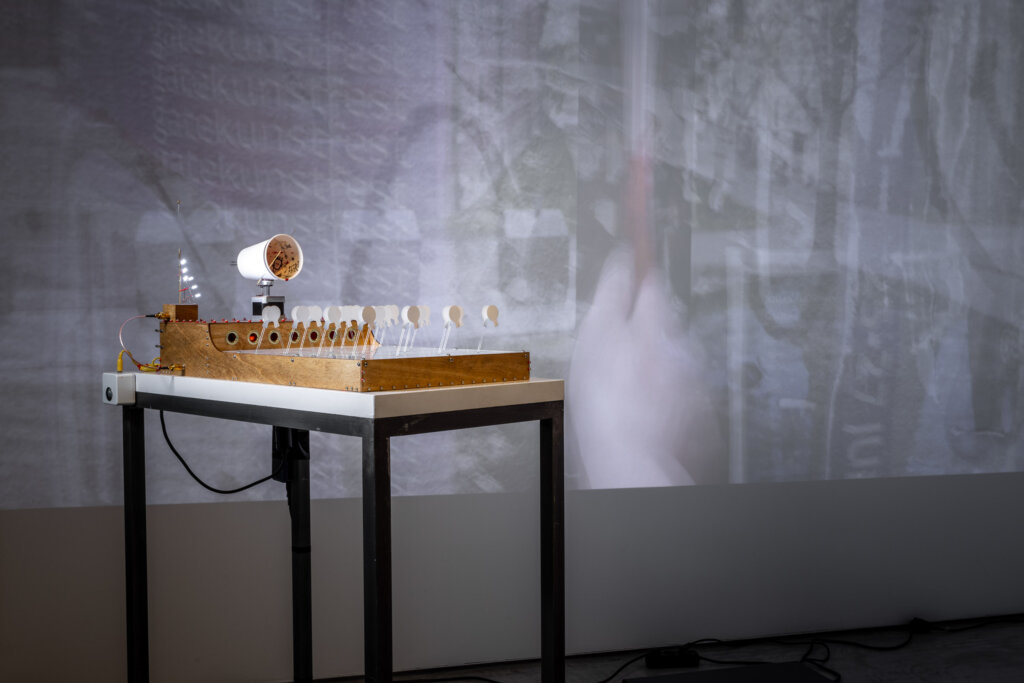‘Koka’s Self-Applauding Machine’
2022

Koka’s Self-Applauding Machine
‘Koka’s Self-Applauding Machine’ (2022) is an electro-mechanical sound sculpture in which a lone performer, made of a stepper motor and a paper cup, plays for an audience of electromagnetic clappers. When the machine is activated, it plays a different variation of a melody, which in turn elicits a unique response from the automated audience. ‘Koka’s Self-Applauding Machine’ questions the role of the viewer and, by humanising the robot, reflects on vulnerability, the contagious nature of clapping or the simple joy of a melody.
Infinite Variations
With its pared-back aesthetic, ingenious use of materials and generative music-making, ‘Koka’s Self-Applauding Machine’ echoes earlier works such as the artist’s ‘Beat Machines’ (2016-present) or the step sequencer ‘Blink Wheel’ (2017). Nikoladze’s interest in stepper motors as instruments was already explored in Koka’s ‘Stepper Miniature’ (2016), and now the motor becomes an autonomous performer. Its sound is amplified by a paper cup, with the lower frequencies amplified by the geometric sound holes in the wooden box. Two solenoids on the back complete the ensemble. “The music is aleatoric,” Nikoladze explains. A code written by the artist strings together short blocks of composed phrases, performing a new variation each time.
Group dynamics and soldering as performance
Sixteen pairs of electromagnets soldered to a circuit board with guitar strings form the audience in ‘Koka’s Self-Applauding Machine’. “One of the hardest things I ever did was soldering guitar strings to flat electromagnets,” recalls the artist, who drew on his experience as a solo violinist to hone his skills. “It was like performing a Rondo Capriccioso by Saint-Saëns. You work out individual movements, you pay attention to both hands, even the way you sit is important. One wrong move and you destroy the electromagnet. So the whole thing, the whole piece is the result of the performance.”
The delicate appearance of the clappers contrasts with the density of the applause they generate. “We take it for granted that we can clap. But it’s not a simple thing, human hands are incredible. The way two hands connect and expel air to create a loud clap is fantastic. To achieve that with small mechanical objects is difficult. It’s even more difficult to model the group dynamic”.
Nikoladze has observed applause patterns at concerts and studied the literature on group dynamics to model applause. “It’s a complicated code that creates these patterns, but then it sounds so organic and human.”
An earworm sung by a paper cup
For the main melody, Nikoladze was keen to explore the concept of so-called earworms, the catchy tunes that inexplicably play over, time and again, in our minds. “I love earworms. I love the Eurovision song contest. It’s my guilty pleasure.” says the artist, whose journey to this piece involved experimentation with voice recordings and countless potential melodies.
Finally, his four-year-old son provided the tune. One cold Oslo morning, Teodor started singing to his dad “You need a coat! You need a coat!” In his quirky version of Georgian, with an acute Norwegian accent, this seven-syllable phrase, stressed on the first and fifth syllables — “shen gch’irdeba kurtuk’i” —became the ideal ingredient for ‘Koka’s Self-Applauding Machine’. “The rhythm was so strange, so beautiful and I couldn’t get this pattern out of my head. It didn’t leave me for a week! And then I thought, ‘That’s what this cup should sing!’ I built the entire musical part around a random phrase that my son gave me one morning.”
Humanised objects and personal experience
‘Koka’s Self-Applauding Machine’ is a profoundly personal work, not only in terms of its base melody. “I felt the need to bake in some of my personal experiences in a very abstract way,” says Nikoladze, who avoids theorising about his sound machines but recognises their autobiographical undertones. The mechanical music-maker is centre stage, elevated and exposed, apparently hinting at the pressure of expectation, performers’ vulnerability and fear of failure. “It’s a paper cup. You can destroy it so easily, you just have to squeeze. The entire thing is so fragile,” says Nikoladze.
The box’s underside, meanwhile, hides a diverse selection of spontaneously selected elements. Wiring and circuitry are joined by tiny toy animals, a lollipop or scratched swear-words, while the board itself is engraved with a shopping list, referencing the artist’s childhood memories of his grandparents. Nikoladze’s long-term interest in humanising beats or inanimate objects — already clear in his training videos for ‘Deluge’ synthesisers or ‘Operation Manual for a Stick’ (2021) — is especially relevant in Koka’s Self-Applauding Machine. The robotic takes on a life of its own, bringing even the role of human observers into doubt. As Nikoladze explains, “Here, everything is contained. There’s the performer and the audience, so you are completely irrelevant.”
